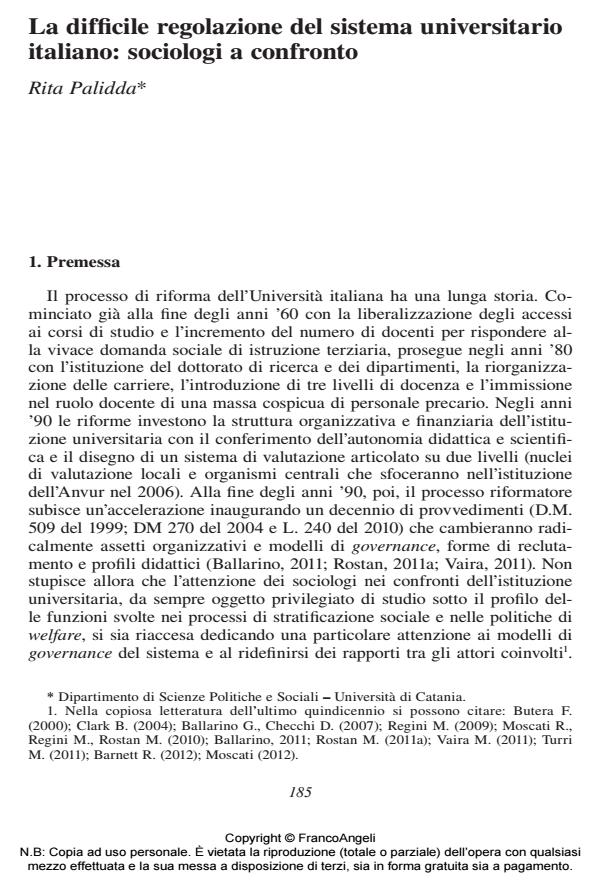The difficulty of university regulation: some sociological consideration about the reform
Journal title SOCIOLOGIA DEL LAVORO
Author/s Rita Palidda
Publishing Year 2014 Issue 2014/135
Language Italian Pages 15 P. 185-199 File size 106 KB
DOI 10.3280/SL2014-135011
DOI is like a bar code for intellectual property: to have more infomation
click here
Below, you can see the article first page
If you want to buy this article in PDF format, you can do it, following the instructions to buy download credits

FrancoAngeli is member of Publishers International Linking Association, Inc (PILA), a not-for-profit association which run the CrossRef service enabling links to and from online scholarly content.
The article analyzes the issues and the effects of university reform debated during the last AIS ELO conference "The failures of regulation". In recent years, the attention of sociologists has shifted from the traditional topic of social stratification and welfare policy to the different models of university governance and the redefinition of its institutional relationships. The reforms of 2000s changed radically the structures of University, its governance system, the recruitment and training path, but the effects of that still remain uncertain and ambivalent. The option of most European universities for a strong control, a reduction of autonomy, the establishment of common standards for recruitment and evaluation, increasing programming obligations, accountability and transparency have met, not only in Italy, strong resistance and not even enthusiastic reception by economic actors. Only the process of implementation of the reform will determine long-term effects on preferences and interactions of all the actors involved.
Keywords: University reform, governance, evaluation, shareholders, stakeholders
- Almalaurea (2014). Condizione occupazionale dei laureati. XVI Indagine.
- Anvur (2013). Rapporto sullo stato del sistema universitario e della ricerca.
- Ballarino G., Colombo S., Perotti L., Regini M., Semenza R. (2010). Il mutamento dei rapporti fra università e sistema economico. In: Moscati R., Regini M., Rostan M., Torri d’avorio in frantumi? Dove vanno le università europee. Bologna: il Mulino.
- Ballarino G. (2006). Stratificazione educativa e stratificazione sociale in Italia: il rendimento occupazionale del settore di studio universitario. In: Ballarino
- G., Checchi D., Sistema scolastico e disuguaglianza sociale. Bologna: il Mulino.
- Ballarino G. (2011). Le politiche per l’università. In: Ascoli U., a cura di, Il welfare in Italia. Bologna: il Mulino.
- Barnett R. (2012). The Future University: Ideas and Possibilities. New York: Routledge.
- Barone C., Boffo S., Di Pietro F., Moscati R. (2010). Le trasformazioni dei modelli di governance. In Moscati R., Regini M., Rostan M., a cura di, cit.
- Becker G. (1964). Human capital. A theoretical and empirical analysis, with special preferences to education. New York: National Bureau of Economic Research.
- Bianco M.L. (2014). Come spiegare la pessima performance della sociologia alla VQR e alla ASN. Testo disponibile al sito internet www.roars.it (1 aprile).
- Butera F. (2000). Adapting the Patterns of University Organization to the Needs of Knowledge Economy. European Journal of Education, 35(4): 403-20. DOI: 10.1111/1467-3435.00036
- Cattero B. (2013), “Controllo senza qualità. False promesse, dimensione organizzativa ed esiti attesi dell’accreditamento nell’università”. Relazione al Convegno nazionale AIS La qualità del sapere sociologico, Firenze 10-12 ottobre.
- Checchi D. (2014), Dove va l’università italiana?, testo disponibile al sito internet www.lavoce.info (22 aprile).
- Clark B. (2004). Sustaining Change in Universities: Continuities in Case Studies and Concepts. Maidenhead: Open University Press-McGraw-Hill.
- Istat (2013). Annuario statistico italiano. Roma.
- Istat (2014). Rilevazione delle forze di lavoro. Roma.
- MIUR (2013). Il passaggio dalla scuola secondaria all’università. Roma.
- Moscati R., a cura di (1997). Chi governa l’università? Il mondo accademico tra conservazione e mutamento. Napoli: Liguori.
- Moscati R. (2012). L’università. Modelli e processi. Roma: Carocci.
- Regini M. (2009). Malata e denigrata. L’università italiana a confronto. Roma: Donzelli.
- Reyneri E. (2011). Sociologia del mercato del lavoro. Le forme dell’occupazione. Bologna: il Mulino.
- Romano A. (1998). A trent’anni dal ’68. ‘Questione universitaria’ e ‘riforma universitaria’. In: Annali di Storia delle Università italiane. Bologna: Clueb.
- Rostan M., a cura di (2011a). La professione accademica in Italia. Cosa fanno e cosa pensano i docenti e i ricercatori delle università italiane. Milano: LED.
- Rostan M. (2011b). “Terza missione, dialettica territoriale e nuove competenze”. Relazione al Convegno L’università che vorremmo. Otto tesi per cambiare, Camerino 24-25 febbraio. Rostan M., Vaira M. (2008). La collaborazione università/industria tra vincoli e opportunità. In: Moscati R., Vaira M. a cura di, L’università di fronte al cambiamento. Realizzazioni, problemi, prospettive. Bologna: il Mulino.
- Sandulli A., Cocconi M. (2012). Istruzione. Riforma universitaria, testo disponibile al sito internet www.treccani.it.
- Turri M. (2012). L’università in transizione. Governance, struttura economica valutazione. Milano: Guerini.
- Vaira M. (2011). La costruzione della riforma universitaria. Idee, nome, pratiche, attori. Milano: LED.
- Internship and employability of graduates in a "glocal" context Davide Arcidiacono, in SOCIOLOGIA DEL LAVORO 137/2015 pp.58
DOI: 10.3280/SL2015-137004
Rita Palidda, La difficile regolazione del sistema universitario italiano: sociologi a confronto in "SOCIOLOGIA DEL LAVORO " 135/2014, pp 185-199, DOI: 10.3280/SL2014-135011